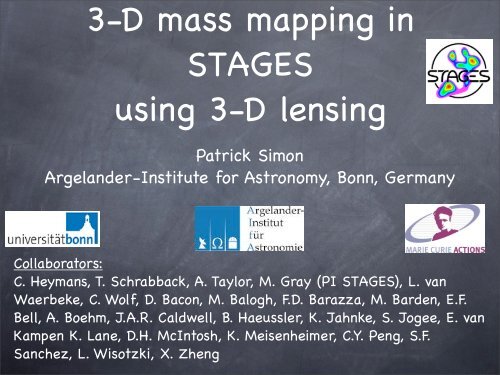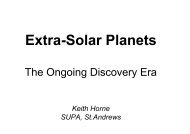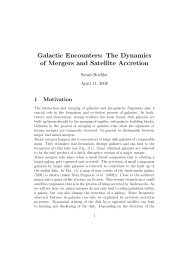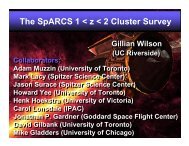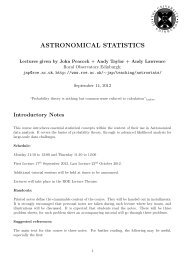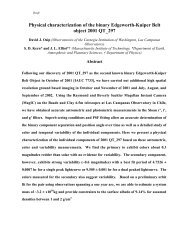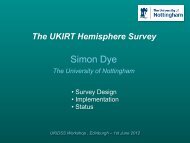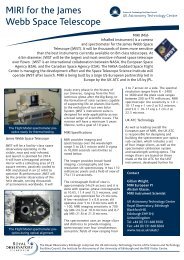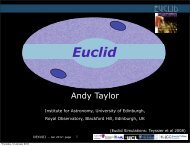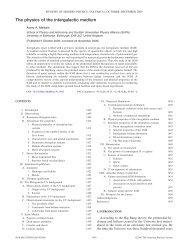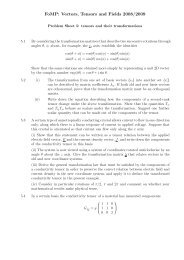Patrick Simon Argelander-Institute for Astronomy, Bonn, Germany
Patrick Simon Argelander-Institute for Astronomy, Bonn, Germany
Patrick Simon Argelander-Institute for Astronomy, Bonn, Germany
Create successful ePaper yourself
Turn your PDF publications into a flip-book with our unique Google optimized e-Paper software.
3-D mass mapping in<br />
STAGES<br />
using 3-D lensing<br />
<strong>Patrick</strong> <strong>Simon</strong><br />
<strong>Argelander</strong>-<strong>Institute</strong> <strong>for</strong> <strong>Astronomy</strong>, <strong>Bonn</strong>, <strong>Germany</strong><br />
Collaborators:<br />
C. Heymans, T. Schrabback, A. Taylor, M. Gray (PI STAGES), L. van<br />
Waerbeke, C. Wolf, D. Bacon, M. Balogh, F.D. Barazza, M. Barden, E.F.<br />
Bell, A. Boehm, J.A.R. Caldwell, B. Haeussler, K. Jahnke, S. Jogee, E. van<br />
Kampen K. Lane, D.H. McIntosh, K. Meisenheimer, C.Y. Peng, S.F.<br />
Sanchez, L. Wisotzki, X. Zheng
Outline<br />
Modified Wiener filtering of 3-D lensing data<br />
Radial debiasing and cleaning of map<br />
Data sample: STAGES<br />
A mass map vs. light map comparison<br />
Conclusions
Weak lensing on a grid<br />
Lensing convergence = projected matter fluctuations<br />
∫ ∞<br />
κ(θ) = 3H2 0 Ω m<br />
2c 2 dw W (w)f k(w)<br />
0 a(w)<br />
〈 〉<br />
fk (w s − w l )<br />
W (w l )=<br />
f k (w s )<br />
w s<br />
δ m (f k (w)θ, w)<br />
δ m<br />
(6)<br />
δ m<br />
(7)<br />
θ<br />
δ m<br />
(5)<br />
δ m<br />
(3)<br />
δ m<br />
(4)<br />
δ m<br />
(1)<br />
δ m<br />
(2)<br />
distance w<br />
us
Weak lensing on a grid<br />
Lensing convergence = projected matter fluctuations<br />
∫ ∞<br />
κ(θ) = 3H2 0 Ω m<br />
2c 2 dw W (w)f k(w)<br />
0 a(w)<br />
〈 〉<br />
fk (w s − w l )<br />
W (w l )=<br />
f k (w s )<br />
w s<br />
δ m (f k (w)θ, w)<br />
Chop 3-D volume into slices of constant matter density<br />
κ(θ) ≈<br />
N lp<br />
∑<br />
i=1<br />
Q i δ (i)<br />
m (θ) ,Q i = 3H2 0 Ω m<br />
2c 2<br />
∫ wi+1<br />
w i<br />
dw W (w)f k(w)<br />
a(w)
Weak lensing on a grid<br />
Lensing convergence = projected matter fluctuations<br />
∫ ∞<br />
κ(θ) = 3H2 0 Ω m<br />
2c 2 dw W (w)f k(w)<br />
0 a(w)<br />
〈 〉<br />
fk (w s − w l )<br />
W (w l )=<br />
f k (w s )<br />
w s<br />
δ m (f k (w)θ, w)<br />
Chop 3-D volume into slices of constant matter density<br />
κ(θ) ≈<br />
N lp<br />
∑<br />
i=1<br />
Q i δ (i)<br />
m (θ) ,Q i = 3H2 0 Ω m<br />
2c 2<br />
∫ wi+1<br />
w i<br />
dw W (w)f k(w)<br />
a(w)<br />
On a grid we may there<strong>for</strong>e write<br />
γ =P γκ κ =P γκ Q δ m
Wiener filter of 3-D lensing data<br />
Combine all “source redshift bins” into one vector<br />
(<br />
) (<br />
)<br />
γ ≡ γ (1) ,γ (2) , . . . =P γκ Q (1) , Q (2) , . . . δ m ≡ P γκ Qδ m<br />
different z-bins<br />
0.3 0.5 0.7 0.9 1.1 1.3 1.5
Wiener filter of 3-D lensing data<br />
Combine all “source redshift bins” into one vector<br />
(<br />
) (<br />
)<br />
γ ≡ γ (1) ,γ (2) , . . . =P γκ Q (1) , Q (2) , . . . δ m ≡ P γκ Qδ m<br />
Need to find solution <strong>for</strong> δ m <strong>for</strong> given cosmic shear:<br />
ɛ =P γκ Q δ m + n<br />
shape noise<br />
Source ellipticities binned on grid
Wiener filter of 3-D lensing data<br />
Combine all “source redshift bins” into one vector<br />
(<br />
) (<br />
)<br />
γ ≡ γ (1) ,γ (2) , . . . =P γκ Q (1) , Q (2) , . . . δ m ≡ P γκ Qδ m<br />
Need to find solution <strong>for</strong> δ m <strong>for</strong> given cosmic shear:<br />
ɛ =P γκ Q δ m + n<br />
Minimum variance solution <strong>for</strong> δ<br />
δ mv<br />
m<br />
= SQ t P † γκ<br />
[<br />
N −1 P γκ QSQ t P † γκ + α1 ] −1<br />
N −1 ɛ<br />
S ≡〈δ m δ t m〉<br />
signal covariance<br />
N ≡〈nn † 〉 noise covariance<br />
<strong>Simon</strong>, P., Taylor, A.N., Hartlap, J., 2009, MNRAS, 399, 48
Wiener filter of 3-D lensing data<br />
Combine all “source redshift bins” into one vector<br />
(<br />
) (<br />
)<br />
γ ≡ γ (1) ,γ (2) , . . . =P γκ Q (1) , Q (2) , . . . δ m ≡ P γκ Qδ m<br />
Need to find solution <strong>for</strong> δ m <strong>for</strong> given cosmic shear:<br />
ɛ =P γκ Q δ m + n<br />
Minimum variance solution <strong>for</strong> δ<br />
δ mv<br />
m<br />
= SQ t P † γκ<br />
[<br />
N −1 P γκ QSQ t P † γκ + α1 ] −1<br />
N −1 ɛ<br />
S ≡〈δ m δ t m〉<br />
signal covariance<br />
N ≡〈nn † 〉 noise covariance<br />
α=1: full Wiener filtering (less noise, biased)<br />
α=0: no prior (plenty noise, unbiased)
Limitations of technique<br />
Mock data<br />
0.5<br />
0.4<br />
0.3<br />
0.2<br />
0.1<br />
on sky<br />
radially<br />
z
Limitations of technique<br />
STAGES<br />
Mock data<br />
re c o nstru c t e d re dshift<br />
0.3<br />
0.5<br />
0.2<br />
0.4<br />
0.1<br />
tru e re dshift<br />
on sky<br />
radially<br />
z
Data sample: STAGES<br />
A901a<br />
about 30 arcmin<br />
α<br />
A901b<br />
21 photo-z slices, z=0...1.3,<br />
with 13 sources/arcmin 2<br />
(matched with COMBO-17 survey)<br />
Three deep mag-bins, m R =[23,27.45]<br />
mag, with 52 sources/arcmin 2<br />
22 lens planes, z=0...1.2<br />
A902<br />
SW<br />
mag bins (GOODS-MUSIC)<br />
STAGES: Gray et al. (2009)<br />
photo-z’s<br />
COMBO-17: Wolf et al. (2004)
Significance of map<br />
about 30 arcmin<br />
3-D mass map (projected onto sky)<br />
A901a<br />
α<br />
A901b<br />
A902<br />
SW<br />
Heymans, C. et al. (2008)<br />
projected S/N surfaces: S/N=2.5,3,3.5...6.0<br />
based on 1000 noise realisations of data
Cleaned and debiased map<br />
A902/SW group region<br />
re dshift<br />
A901 a<br />
A901b<br />
On-sky projection<br />
!<br />
DE C<br />
R.A.<br />
A901a/A901b region<br />
re dshift<br />
C BI<br />
SW<br />
<strong>Simon</strong>, P., Heymans, C., Schrabback,T.,<br />
2010, submitted<br />
A902<br />
SW /1<br />
SW /2<br />
DE C<br />
R.A.
Mass vs. light comparison<br />
Bin galaxy M star -masses (mass in stars) on grid and crosscorrelate<br />
with lensing mass map:<br />
∑<br />
δ (i)<br />
lum (θ) = j∈M i (θ) M ∗,j<br />
M ∗<br />
− 1 ; CCM(θ) = δ lum(θ)δ m (θ)<br />
σ lum σ m<br />
M star light map<br />
Correlation map<br />
A901a<br />
A901b<br />
A902<br />
SW group<br />
z=0.0-0.36
Mass vs. light comparison<br />
Bin galaxy Mass S/N M star -masses (mass in stars) on grid and crosscorrelate<br />
cleaned with lensing mass map:<br />
map redshift<br />
δ (i)<br />
lum (θ) = ∑<br />
j∈M i (θ) M ∗,j<br />
M ∗<br />
M star light map<br />
− 1 ; CCM(θ) = δ lum(θ)δ m (θ)<br />
σ lum σ m<br />
A901a<br />
red galaxies<br />
A901b<br />
CCM<br />
A902<br />
M star mass<br />
SW group<br />
blue galaxies<br />
z=0.0-0.36
Mass vs. light comparison by eye<br />
A901a<br />
A901b<br />
A902<br />
SW group<br />
Radial spread of A901a noise artefact?
Mass vs. light comparison by eye<br />
A901a<br />
A901b<br />
A902<br />
SW group<br />
Radial spread of A901a noise artefact?<br />
Light confirms structure behind A901b (z=0.70-0.80)
Mass vs. light comparison by eye<br />
A901a<br />
A901b<br />
A902<br />
SW group<br />
Radial spread of A901a noise artefact?<br />
Light confirms structure behind A901b (z=0.70-0.80)<br />
Light confirms structure behind SW group (z=0.43?,0.80)
Mass vs. light comparison by eye<br />
A901a<br />
CB1<br />
A901b<br />
A902<br />
A902<br />
SW group<br />
Radial spread of A901a noise artefact?<br />
Light confirms structure behind A901b (z=0.70-0.80)<br />
Light confirms structure behind SW group (z=0.43?,0.80)<br />
CB1 reconfirmed (COMBO-17; Taylor et al. 2004: z=0.46)
Light-mass cross-correlation coefficient<br />
10//<br />
:;
Conclusions<br />
This work is an application of a new lensing 3-D mass mapping<br />
algorithm to real data<br />
The modified Wiener filter produces a biased image of the<br />
true distribution; z-shift bias can be corrected <strong>for</strong><br />
Annoyance of radial cigar-effect inside maps can be partly<br />
removed with heuristic cleaning algorithm presented<br />
3-D map reveals structure behind A901b and SW-group;<br />
may be important <strong>for</strong> lensing mass modelling<br />
Good light-mass match at z
Quality control
Quality control<br />
Frequency statistics of noise peaks<br />
noise<br />
B-mode<br />
E-mode<br />
Peaks: pixel larger than all neighbour<br />
pixels in transverse&radial direction<br />
Troughs: negative peaks<br />
Noise realisations vs. E/B-mode maps
Quality control<br />
Frequency statistics of noise peaks<br />
noise<br />
B-mode<br />
E-mode<br />
Peaks: pixel larger than all neighbour<br />
pixels in transverse&radial direction<br />
Troughs: negative peaks<br />
Noise realisations vs. E/B-mode maps<br />
tan. shear<br />
Z-scaling of tan. shear inside<br />
apertures (≈1-2 arcmin radius)<br />
mag<br />
rad. shear<br />
γ t (θ c ,z s )=− ∑<br />
i∈M s (z s )<br />
θi ∗ − θ∗ c<br />
ɛ i<br />
θ i − θ c<br />
ε i<br />
θ i<br />
θ c<br />
targets: A901a/b/α, SW and A902
A902 region/less smoothing<br />
CBI<br />
A902<br />
re dshift<br />
C BI<br />
SW<br />
A902<br />
SW /1<br />
SW /2<br />
R.A.
Degradation of correlations<br />
Cross-correlation coefficient between maps:<br />
r = 〈CCM(θ)〉 = 〈δ (θ)δ (θ)〉<br />
σ σ <br />
; − 1 ≤ r ≤ +1
Degradation of correlations<br />
Cross-correlation coefficient between maps:<br />
r = 〈CCM(θ)〉 = 〈δ (θ)δ (θ)〉<br />
σ σ <br />
; − 1 ≤ r ≤ +1<br />
Noise degrades the correlation but can be corrected if<br />
signal and noise power are known:<br />
r true = r ×<br />
√ (<br />
1+ 〈noise2 lum〉<br />
〈signal 2 lum〉<br />
)(<br />
)<br />
1+ 〈noise2 m〉<br />
〈signal 2 m〉<br />
Noise and signal variances are estimated from noise<br />
realisations of mass and light maps;<br />
Map pixel variance = noise variance + signal variance!


